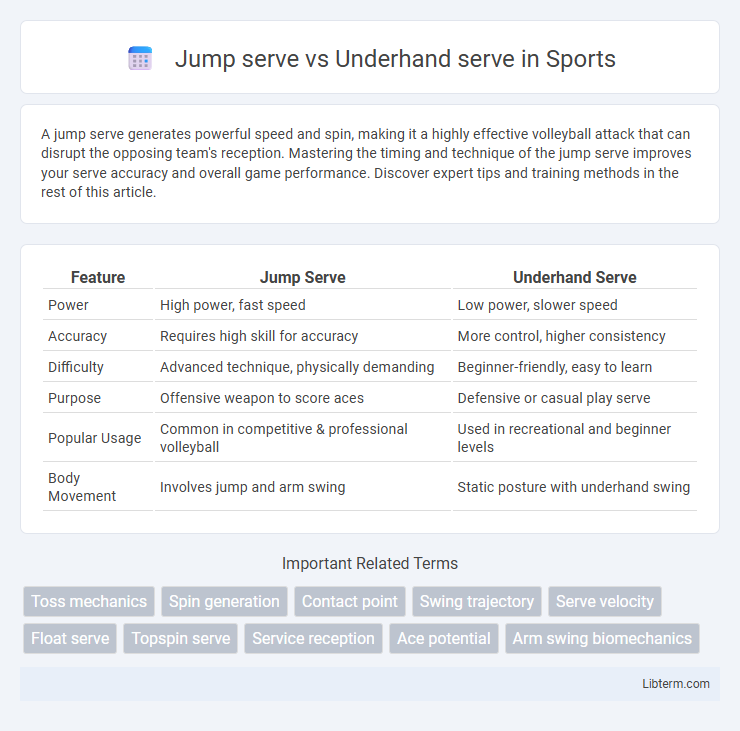A jump serve generates powerful speed and spin, making it a highly effective volleyball attack that can disrupt the opposing team's reception. Mastering the timing and technique of the jump serve improves your serve accuracy and overall game performance. Discover expert tips and training methods in the rest of this article.
Table of Comparison
| Feature | Jump Serve | Underhand Serve |
|---|---|---|
| Power | High power, fast speed | Low power, slower speed |
| Accuracy | Requires high skill for accuracy | More control, higher consistency |
| Difficulty | Advanced technique, physically demanding | Beginner-friendly, easy to learn |
| Purpose | Offensive weapon to score aces | Defensive or casual play serve |
| Popular Usage | Common in competitive & professional volleyball | Used in recreational and beginner levels |
| Body Movement | Involves jump and arm swing | Static posture with underhand swing |
Introduction to Volleyball Serving Techniques
Jump serve generates higher ball speed and increased spin, making it a powerful offensive weapon in volleyball, while underhand serve offers better control and is easier for beginners to master. The jump serve requires advanced coordination and timing to maximize effectiveness, whereas the underhand serve relies on consistent contact and placement. Mastery of both techniques enhances a player's versatility and overall serving strategy on the court.
What is a Jump Serve?
A jump serve is an aggressive volleyball technique where the player tosses the ball high, jumps, and strikes it at the peak of their jump to generate maximum power and speed. This serve typically results in a faster, more unpredictable ball trajectory compared to an underhand serve, making it harder for the receiving team to execute a clean pass. The jump serve demands strong leg power, precise timing, and excellent hand-eye coordination to effectively disrupt the opponent's reception.
Understanding the Underhand Serve
The underhand serve is a fundamental volleyball technique characterized by a low toss and a smooth swinging motion, offering greater control and accuracy, especially for beginners. This serve allows players to focus on placement rather than power, making it effective in maintaining consistency during rallies. Compared to the aggressive jump serve, the underhand serve minimizes errors and is ideal for beginners aiming to develop solid serving skills.
Key Differences Between Jump Serve and Underhand Serve
The key differences between jump serve and underhand serve lie in technique, power, and effectiveness. Jump serves generate significantly higher ball speed and spin due to the airborne strike, making them ideal for aggressive, offensive play. Underhand serves prioritize control and accuracy, typically used for consistent serves and easier ball placement but produce lower velocity compared to jump serves.
Advantages of the Jump Serve
The jump serve generates higher ball velocity and increased spin, making it more challenging for opponents to predict and return effectively. It provides greater court coverage by allowing players to serve from an elevated position, creating steeper trajectories and harder angles. This dynamic serve enhances offensive momentum and pressure, often leading to aces or weak returns that facilitate easier attacks.
Benefits of the Underhand Serve
The underhand serve offers greater control and accuracy, making it ideal for beginners and players focusing on consistent ball placement. It reduces the risk of service errors due to its simpler technique and lower power, ensuring reliable play under pressure. This serve also conserves energy, allowing players to maintain stamina during long matches or intense rallies.
Skill Level Requirements for Each Serve
The jump serve demands advanced coordination, timing, and power, making it suitable for experienced volleyball players with developed aerial control and strong upper body strength. The underhand serve requires basic hand-eye coordination and minimal technique, making it ideal for beginners or players focusing on consistency and accuracy. Mastery of the jump serve can enhance offensive advantage, while the underhand serve is often used for steady play and serve-receive situations.
Tactical Uses in Game Situations
The jump serve generates high ball speed and spin, making it effective for aggressive point scoring and pressuring the opponent's reception in competitive volleyball matches. In contrast, the underhand serve offers greater control and accuracy, ideal for maintaining consistent play during crucial moments or targeting specific weaker passers on the opposing team. Coaches often deploy jump serves to disrupt offensive setups, while underhand serves are tactically used to minimize service errors and stabilize team defense.
Common Mistakes and Corrections
Common mistakes in a jump serve include improper timing and insufficient knee bend, causing loss of power and control, while corrections involve practicing consistent toss height and strengthening leg muscles for a stronger takeoff. In underhand serve errors, players often strike the ball too low or use a stiff arm, leading to poor ball trajectory; improving wrist snap and contact point can enhance accuracy and speed. Emphasizing proper posture and follow-through in both serves reduces fault rates and improves serve consistency.
Choosing the Right Serve for Your Game
Selecting the appropriate serve type depends on your skill level, game strategy, and the opponent's weaknesses. The jump serve offers powerful speed and aggressive placement, ideal for advanced players seeking to disrupt the opponent's reception. Underhand serves provide control and consistency, making them suitable for beginners focusing on accuracy and reducing service errors.
Jump serve Infographic

 libterm.com
libterm.com